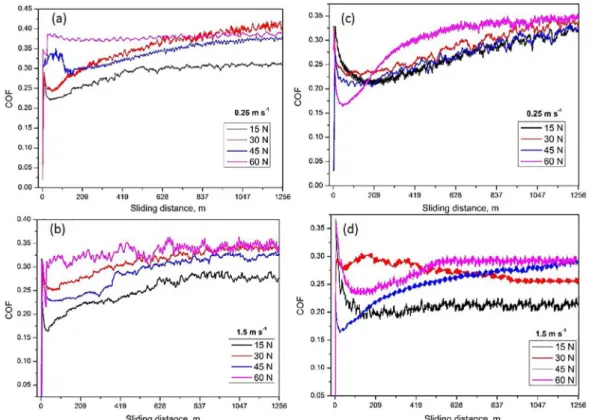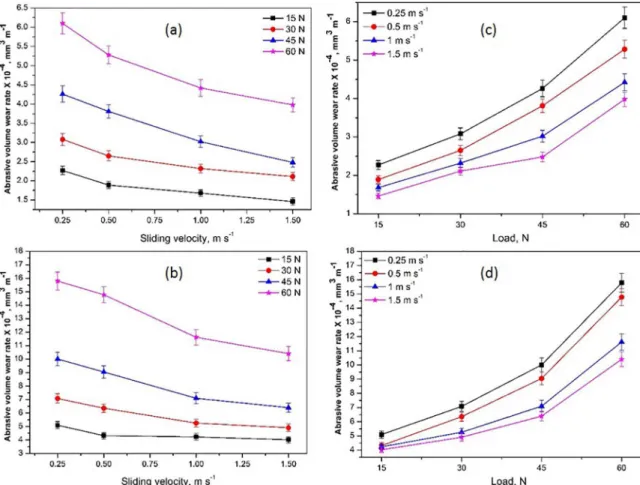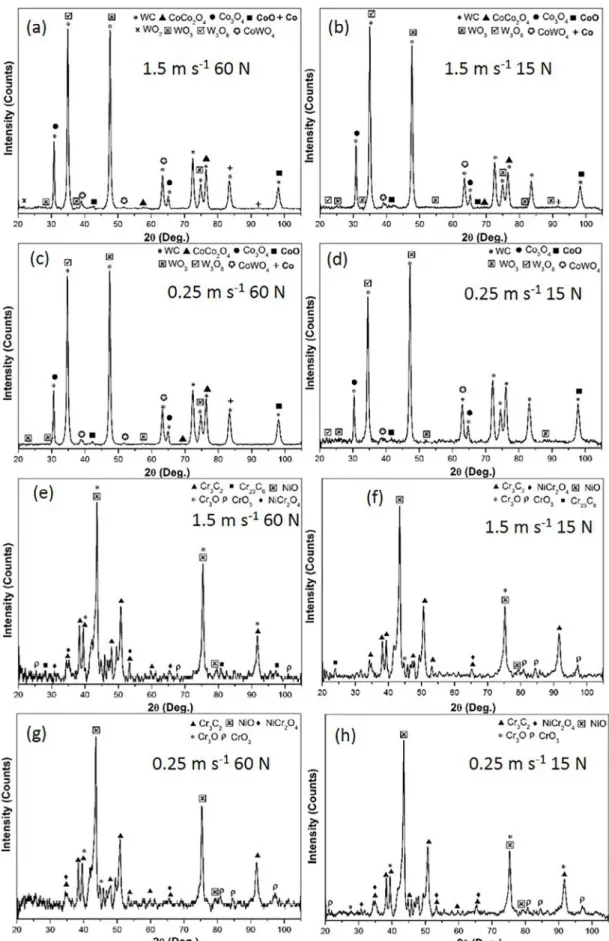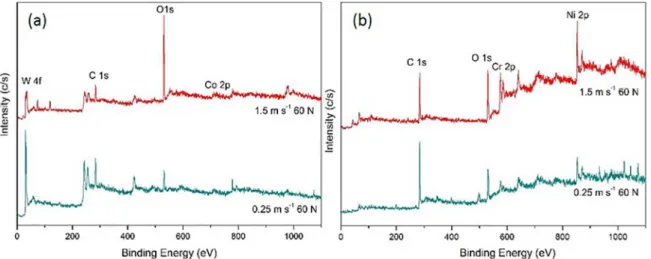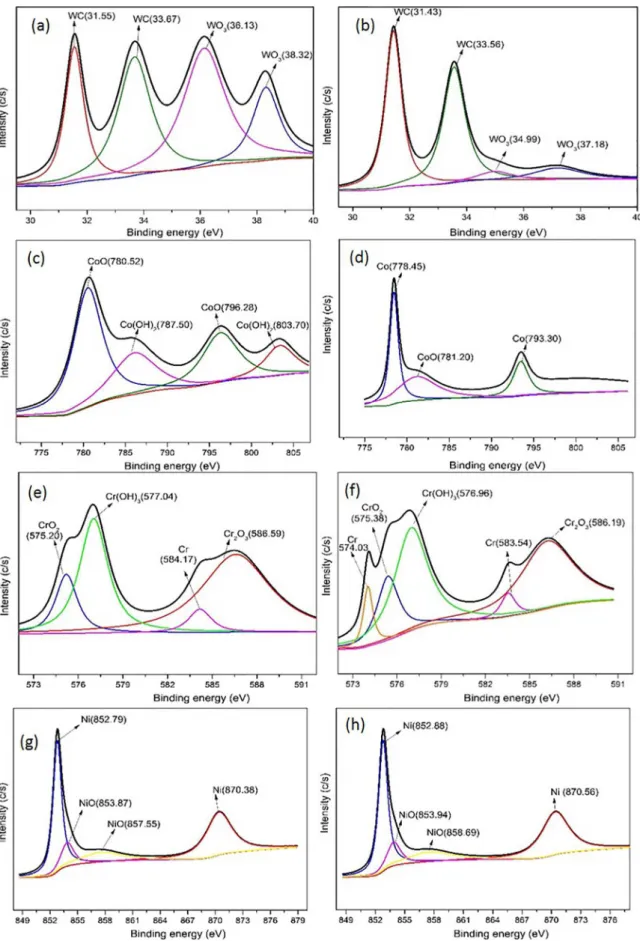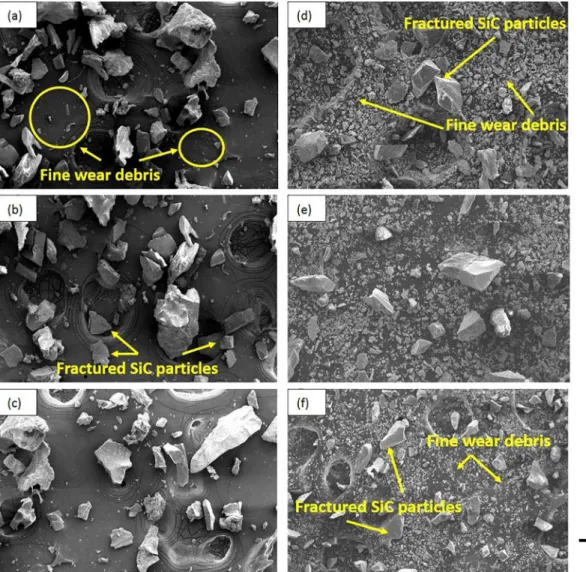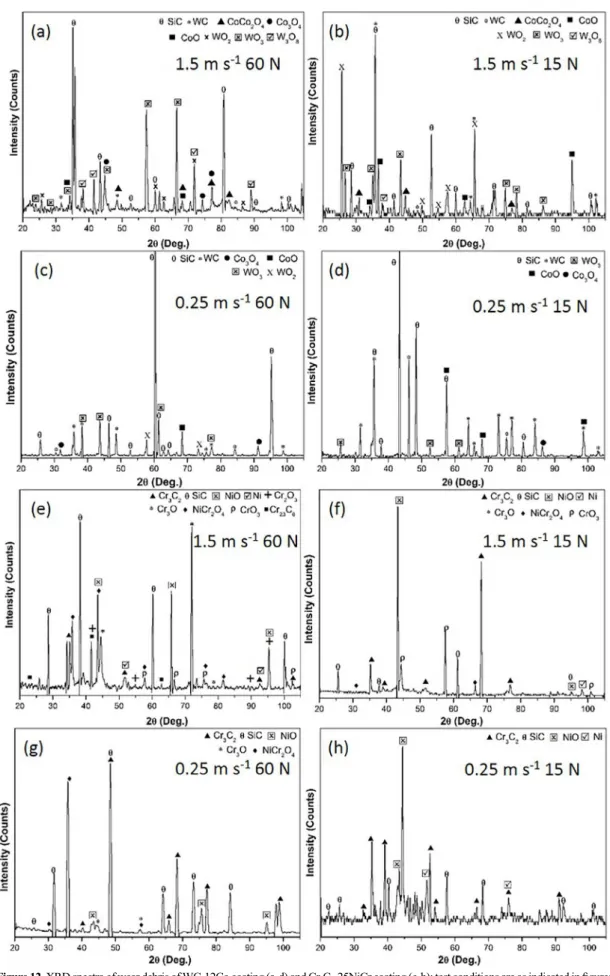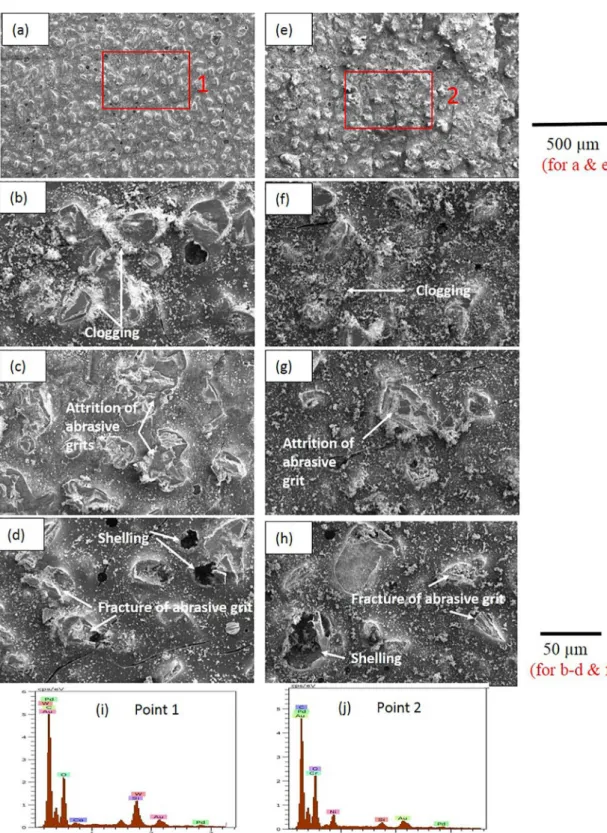Effect of Experimental Parameters on Wear Response of Thermally Sprayed Carbide
Based Coatings
Nitesh Vashishthaa* , Sanjay Sapatea
Received: July 06, 2018; Revised: September 24, 2018; Accepted: October 03, 2018
Friction and abrasive wear response of WC-12 Co and Cr3C2-25 NiCr coatings was studied. Abrasive wear experiments were conducted with SiC abrasive particles with varying load and sliding speeds. The results were analyzed using SEM, XRD and XPS observations of worn surfaces, wear debris and
worn out abrasive paper. Friction coefficient diminished with rise in sliding speed and increased for
increase in load while wear rates decreased for increasing sliding speed for both coatings. WC-12 Co coating had better wear resistance than Cr3C2-25 NiCr coating while Cr3C2-25 NiCr coating displayed
lower friction coefficient. The variation in wear rate and friction response of coatings was due to combined effects of adhesion, abrasion and tribo oxidation effects. The composition of tribo films was strongly influenced by load and sliding velocity and altered friction and wear response of the coatings.
Keywords: Thermal spray coating, abrasion, particle size, fracture.
* e-mail: niteshsharma282@gmail.com
1. Introduction
Thermally sprayed cermet coatings based on hard carbide phases like WC, and Cr3C2 are increasingly used for mitigation against high temperature, wear and corrosion to increase life of engineering components. High Velocity Oxy Fuel (HVOF) sprayed WC-Co and Cr3C2-NiCr coatings are suitable for
different wear conditions due to higher hardness and good
toughness. The major applications of carbide based coatings are in automobile, aerospace, power generation, hydraulic, steel, mining and paper industries. Typical abrasive wear applications include landing gears of aircrafts, fans used in cement industries, sand pumps and tool bits etc. 1-9. Coating
composition, microstructure and mechanical properties
are crucial factors influencing their tribological behaviour.
Carbide dissolution and formation of brittle carbides during
thermal spraying process had significant influence on wear
tribological behaviour of coatings 1,10-14. HVOF process is the
best method to deposit WC-Co and Cr3C2-NiCr type coatings as compared to other thermally sprayed techniques (e.g. plasma
spray, detonation gun, flame spray etc.) 15-19. High particle
velocity and low flame temperature in HVOF process leads to
low decomposition of WC and Cr3C2 particles, which has been
reported beneficial for wear resistance of WC-Co and Cr3C2
-NiCr coatings 16,20,21. The initial coating powder morphology,
carbide particle size, volume fraction of carbide, binder phase and coating spray parameters (e.g. velocity, temperature, pressure,
fuel type) affect structure and properties of the coating 4,5,20,22-28.
WC-17Co coatings with fine carbide grain size distribution had
lower abrasive wear resistance due to more decomposition of WC into W2C which is detrimental for abrasive wear resistance,
as reported earlier 24. Yang et al. reported that wear rate was more
sensitive to carbide size rather than the hardness and toughness of the coating 29. Cr
3C2-NiCr coating having nano crystalline
grains (CNG) exhibited lower friction coefficient around than conventional grains coating (CGC) which was due to different
material removal mechanisms 30.
The assessment of performance of thermally sprayed coatings
is complicated due to different response shown by hard particles
and soft matrix phase, under wear situations involving solid particles 31. The important factors which influence abrasive wear
behaviour of carbide based coatings are carbide particle size, hardness of carbide phase, nature of binder apart from abrasive particle properties; size, shape and hardness. The important abrasive wear mechanisms in WC and Cr3C2 based coatings involve fatigue, binder extrusion, carbide pull out, carbide fracture, intergranular cracking and splat fracture severity of which depends on abrasive wear situations 9,19,32,33. Tribo film formation during
abrasive wear process also alters wear and friction response
of thermally sprayed cermet coating as influenced by sliding
speed, load, nature, composition and thermodynamic stability of oxides 19,34,35. The formation of WO
3, dense CoWO4 tribo films
due to tribo oxidation phenomenon helped in reducing friction
coefficient and wear rate of WC-Co coating, whereas spinel
phase NiCrO4 formation in abrasive wear of Cr3C2-NiCr coatings resulted in improved friction and wear response 19,35. Mohanty et
al. found that friction coefficient showed decreased for increasing
sliding velocity in case of Cr3C2-NiCr coating 36. Wear rate and
coefficient of friction (COF) for carbide based coatings reduced for increasing sliding speed while effect of load on COF and
wear rate depends upon coating composition, wear mode and wear test parameters 19,35,37-39.
aDepartment of Metallurgical and Materials Engineering, Visvesvaraya National Institute of Technology (VNIT),
Abrasive wear rate increased with abrasive particle size up to a critical particle size of 100-150 µm and then remained more or less constant 40-42. The wear and friction
behaviour of stainless steel, ferritic and martensitic steel
was explained in terms of particle size effect; i.e., clogging,
capping, attrition and shelling of abrasive particle during abrasive wear 43-45. The increased wear rate of WC-Co -Cr
coating with increasing abrasive size was due to change in wear mechanism from plastic grooving to fracture 5.
Using factorial design approach it was concluded that
effect of load rather than abrasive size on wear rate of
Co-CrC coating was dominating 8. Pirso et al. found that
abrasive wear performance of TiC-NiMo and Cr3C2-Ni
coatings was inferior to WC-Co coating due to different binder hardness and its effect on wear mechanisms 46.
TiC-Ni based coating showed increased abrasive wear loss of around seven times for increase in abrasive size from 30 µm to 200 µm 47.
In the previous study 19, friction and wear behaviour
of WC-12 Co and Cr3C2-25 NiCr coatings were studied with 150 µm SiC particles, in which friction behaviour of
coating was predominantly influenced by abrasion. The particle size effect is established in the literature however, the effect of tribo oxidation in modifying adhesion and
abrasion component of friction with decrease in abrasive particles size has not been studied previously. This has been the impetus for the present investigation. The present work is aimed at studying abrasive wear and friction and response of WC-12 Co and Cr3C2-25 NiCr coatings
for different loads and sliding speeds using 50 µm SiC particles. The Tribo oxidation effects were analyzed
comprehensively. SEM, XRD and XPS analyses of worn surfaces provided an insight into tribo mechanisms and
formation of tribo chemical reaction films.
2. Experimental Procedure
2.1 Coating powders, deposition and
Characterisation
Two commercial powders WC-12%Co (WOKA 3102) and Cr3C2-25%NiCr (WOKA 7202) manufactured by sintering and agglomeration route by Sulzer Metco, Germany were used in this study. The powders were in size range of - 45 µm + 15 µm with spherical shape. Both the coatings were deposited on 316 stainless steel substrate. The coating deposition parameters, substrate preparation and other details regarding structural characterization and mechanical property measurement are described in previous publication 9,19.
2.2 Wear experiments
Wear testing was performed using Pin on Disc setup with SiC (50 µm) abrasive paper, at room temperature. Wear test conditions were; 15 , 30 , 45 , and 60 N load with sliding
speeds of 0.25, 0.5, 1.0 and 1.5 m s-1 and sliding distance
was 1271 m. The specimens were in cylindrical form of 25 mm length and diameter 10 mm. The details regarding specimen preparation for wear testing and method of wear testing is detailed in previous publication 19. Frictional force
during abrasive wear testing was continuously recorded to
determine coefficient of friction (COF). The morphology of
worn surfaces and wear debris was examined and analyzed by using SEM, EDS, XRD and XPS. Carbon peak corresponding to 284.6 eV binding energy was used as the reference. XPS
peak 4.1 software was used to fit XPS peaks. The binding
energies of various phases were revealed by Standard Reference Database 20, (NIST), Version 4.1.
3. Results
3.1 Properties of coatings
Fig. 1a and 1b shows the lamellar microstructure of WC-12 Co and Cr3C2-25 NiCr coatings, respectively. WC and Cr3C2 particles were uniformly disperse in cobalt and nickel-chrome binder, respectively in WC-12 Co and Cr3C2-25 NiCr coatings were forming a dense coating structure with lower porosity. EDS spectra revealed the W, Co were the main elements in WC-12Co coating (Fig. 1c) while Cr, Ni were the main element in Cr3C2-25 NiCr coating (Fig. 1d). WC particles (bright regions) were surrounded by Co binder in WC-12Co coating (Fig. 1a). In Cr3C2-25 NiCr coating, Cr3C2 particle observed as grey regions which were surrounded by dark grey NiCr binder (Fig. 1b). No microcracking was seen on the both coating surfaces. Cross-sectional micrographs were used for measuring porosity, carbide size by image analysis. The average size of WC and Cr3C2 particle size was 1.5 ± 0.5 µm and 2.5 ± 0.5 µm, respectively. The calculated area percentage porosity was 1.2 % and 1.5 % for WC-12 Co and Cr3C2-25 NiCr coatings, respectively. WC-12Co coating showed higher microhardness (1270 ± 100 HV) than Cr3C2-25 NiCr coating (825 ± 80 HV). The indentation fracture toughness measured on cross-section was 4.5 ±
1.0 M Pa√m and 3.7 ± 0.9 M Pa√m for WC-12 Co and
Cr3C2-25 NiCr coatings, respectively 9.
3.2 COF and wear rate
Typical coefficient of friction curves of both the coatings at different sliding speeds (0.25-1.5 m s-1 and
Figure 1. SEM micrographs of microstructure of coatings (a) WC-12Co (b) Cr3C2-25NiCr and EDS analysis of coatings (c) WC-12Co (d) Cr3C2-25NiCr.
Figure 2. COF curve variations under different abrasive wear conditions for (a,b) WC-12Co coating and (c,d) Cr3C2-25NiCr
the asperity junction and COF. With further sliding, wear debris generated due to plastic deformation covers the coating surface, causing an increase in adhesion, resulting
in rise in friction force and COF. The fluctuations in COF
curve can be attributed to formation and delamination of tribolayer and formation of tribo chemical reaction
films on the worn surface, which is discussed in section
4. With increasing sliding distance more and more wear debris is generated due to plastic deformation and fracture depending upon load. Similarly, more and more abrasive particle fracture and fragmentation occur with increase in sliding distance and load. With increasing sliding speed and load both oxidative wear and mechanical wear prevail
leading to removal of tribo oxide film by delamination
cracking and fracture which generates oxide debris. The wear debris, fractured abrasive particles and oxide debris results in material removal by three body abrasion and tend to increase friction force and COF with increasing sliding distance particularly at higher loads, which is discussed in detail in section 4.
COF values were plotted vs. load and sliding velocities for both coatings, as displayed in Fig. 3(a-d),
respectively. Friction coefficients for WC-12 Co coating
were observed to be 0.29-0.38, 0.28-0.35, 0.27-0.33 and 0.24-0.30 for velocities of 0.25, 0.5, 1.0 and 1.5 m s-1, and for load range of 15-60 N, respectively. While
the respective COF values were 0.26-0.35, 0.25-0.32, 0.24-0.29 and 0.21-0.28 for Cr3C2-25 NiCr coating. COF showed decreasing trend with increasing sliding speed (0.25 - 1.5 m s-1), for both the coatings. For both coatings,
lowest friction coefficient was noted at 1.5 m s-1 velocity,
irrespective of the load. It was seen from graphs that the decrease in COF was not more than 20 % for increase in sliding speed, for both coatings. For both coatings, COF displayed an increasing trend, for entire range of sliding speeds with an increase in load from 15 to 30 N followed by a decrease to 45 N and further increased when the load is reached to 60 N. It can be noted that COF values at 30 N and 60 N were nearly similar or slightly higher at 60 N, as shown in Fig. 3(c-d). The rise in COF was in the range of 21-31 % in case of WC-12 Co coating while for Cr3C2-25 NiCr coating, the increase in COF was 23-34 % when the load is increased from 15-60 N. Fig. 2 also showed that depending on sliding speed and load, COF values were 7-15% lower for Cr3C2-25 NiCr coating than WC-12 Co coating.
Figure 3. COF vs. sliding velocity plots of coatings (a) WC-12Co (b) Cr3C2-25NiCr and COF vs. load plots of coatings (c) WC-12Co
The wear rates for change in load and sliding speed for coatings are displayed in Fig. 4(a-d). Wear rate of both coatings showed decreasing trend for increase in sliding velocity (0.25 to 1.5 m s-1). With WC-12 Co coating, the
wear rates diminished by 31-42% while this decrease was in the range of 22-36 % for Cr3C2-25NiCr coating within 15-60N load range. Within the load range of 15-60 N load, increase in wear rate was 2.68, 2.79, 2.63 and 2.72 times for sliding velocities of 0.25, 0.5, 1.0 and 1.5 m s-1, respectively
for WC-12 Co coating while corresponding increase was 3.09, 3.42, 2.74 and 2.58 times for Cr3C2-25 NiCr coating. Cr3C2-25 NiCr coating showed 2.2-2.8 times higher abrasive wear rates, than WC-12 Co coating, within the range of load and sliding speed.
3.3 Wear mechanisms
SEM micrographs of worn surfaces for both the coatings,
at different sliding speeds and loads are shown in Figs.
5(a-h) and 6(a-h), respectively. From the worn surfaces it was observed that the severity of abrasion increased for rise in load from 15 to 60 N. At lower sliding speeds of less than 1 m s-1 (0.25 - 0.5 m s-1) and up to load of 30 N for
WC-12Co coating, the abrasive wear mechanism involved
displacement of carbide grains, plastic grooving and binder extrusion, which can be seen in Fig. 5a. Compressive stresses exerted by hard abrasive SiC particles results in binder extrusion and removal of cobalt binder phase, which leads to loss in mechanical strength and subsequent decrease in the support to WC carbide. This resulted in displacement of mechanically loosed WC particles and their bodily removal from the coating matrix by the action of repeated cyclic fatigue with increasing load 9,33. At 45-60 N load,
rise in wear rates were associated with increased depth of grooving, fracture of carbides, carbide pull out and inter granular cracking as seen in Fig. 5(b-c). The propensity of carbide pull out increased with load, as fractured abrasive
particle can effectively undermine the binder phase. The
material removal mechanisms from the Cr3C2-25NiCr
coating under abrasive wear conditions were similar to the WC-12Co coating. In Cr3C2-25NiCr coating relatively high percentage of binder content resulted in more binder phase extrusion, which can be seen in Fig. 6(a) at 30 N load and 0.25 m s-1 sliding speed. At higher loads, worn surface
showed fracture and pull out of carbide grains (Fig. 6b-c). Carbide pull out, inter granular cracking and inter splat fracture leads to higher abrasive rates 11,19.
Figure 5. (a-h) SEM micrographs of worn out surafces of WC-12Co coating at different abrasive wear conditions. EDS analysis of selected points (i-k).
Cr3C2-25 NiCr coating showed higher abrasive rates than WC-12 Co coating, which were due to lower fracture toughness of Cr3C2-25 NiCr coating than WC-12 Co coating
9. With rise in sliding speed, oxidative wear mechanism also
played an important role in altering friction and wear response of coatings. As the sliding velocity is increased from 0.25-1.5 m s-1, the propensity of tribo oxidation increased which is
evident from morphology worn surfaces of both coatings, as shown in Fig. 5(c-h) and 6(c-h). During wear, some of the debris particle get swept away while some retained in wear tracks are subjected to oxidation due to frictional heating. The fragmentation, oxidation, agglomeration and subsequent
compaction forms a tribo-film separating contact between
the abrasive particles and the worn surface and prevents further damage, as summarized previously 19.
As the flash temperature is increased, the adhesive forces
between individual oxide wear debris became stronger and
enhances the compaction of tribo film to the coating surface.
This tribo layer having lower shear strength serves as solid lubricant and prevents further damage to the worn surface reducing not only wear rate but also COF 19,34,48. At higher
sliding velocity of 1.0 and 1.5 m s-1, intense frictional heating
caused oxidation of worn surface and resulted in covering
of worn surface with tribo film (Fig. 5d-h and 6d-h). Wear tracks filled with oxide debris and number of hot spot patches confirming the localized heating, which can be observed in Fig. 5e-h and 6e-h. tribo film effectiveness in reduction of COF and wear rate is affected by its thermodynamic stability,
adherence with the substrate, nature and its composition
19,49. The tribo film is expected to be removed by shearing
process at lower loads rather than by delamination cracking at higher loads as shown in Fig. 5(e,g,h) and Fig. 6(e,g,h),
which also indicates fractured tribo film. With the removal of tribo film the contact conditions are modified, fresh contact
with varying sliding speed and load and can be assessed by
rise in flash temperature, EDS, XRD, XPS analyses of worn
surface, which is discussed in subsequent sections. Frictional heat developed during abrasive wear leads to
rise in flash temperature, at real contact area, which accelerates tribo-oxidation reactions resulting in tribo-oxide film formation. The increase in flash temperature with varying load and
sliding speed provides useful information which can be used
to predict different oxidation regimes from mild to severe.
The increase in localized temperature at asperities junctions,
i.e. flash temperature, was calculated as per equation 150,51,
,
T
J Ka Kcoat a PV
Where a
Hcoat P
4
1 2
n
r
D = +
=
Q
S
X
V
(1)
where, ∆T = increase in flash temperature (ºC), P = test load (N), µ = frictional coefficient, V= sliding speed (m s-1),
J = Joule’s constant (1), Kcoat and Ka are thermal conductivity
of coating and SiC abrasive, a= real area of contact (m), Hcoat
= coating hardness (N m-2).
Flash temperatures increased for increase in both, load (15-60 N) and speed (0.25-1.5 m s-1), as shown in
Fig. 7. The calculated flash temperature were in the range of 197-2496ºC and 179-2306ºC in case of WC-12 Co
and Cr3C2-25 NiCr coatings, respectively. It is also noted
that rise in flash temperatures were much higher than
the actual surface temperature of the coating surface i.e. bulk temperature 52. The estimated flash temperatures are
approximate, because the thermal conductivity of oxide was not taken into account.
Figure 6. (a-h) SEM micrographs of worn out surafces of Cr3C2-25NiCr coating at different abrasive wear conditions. EDS analysis of
3.4 Characterization of worn surface
EDS spectrum of worn surfaces of WC-12 Co coating showed peaks of oxygen (O) along with tungsten (W) and cobalt (Co) as shown Fig. 5(i-k). In Cr3C2-25NiCr coating, EDS also revealed the peaks of O along with the chromium (Cr) and nickel (Ni) elements (Fig. 6i-k), suggesting formation of various oxide of Co, W, Cr and Ni. The concentration of oxygen increased for an increase in sliding speed and load, for both coatings, which was in the range of 19-41 % in case of WC-12Co coating while in case of Cr3C2-25NiCr coating this range was 22-36 %, depending upon the load and sliding velocity, thus suggesting increased tribo oxidation. XRD analyses of worn surface of WC-12Co coating (Fig. 8a-d) showed peaks of tungsten oxides (WO2, WO3, W3O8), cobalt oxides (CoO, Co3O4, CoCo2O4), spinel phase CoWO4 along with peaks of WC and Co. In case of Cr3C2-25NiCr coating, peaks of Cr3C2, Cr23C6, Cr3O, CrO3, NiO and spinel phase NiCr2O4 were recorded (Fig. 8e-h). The number of oxide peaks and increased intensity of oxide peaks for rise in both, load and sliding velocity confirmed the prevalence of oxidative wear.
XPS analyses was performed to assess composition of different products of tribo chemical reaction, during abrasive of both the coatings. Fig. 9(a-b) showed XPS surface survey worn surface of both coatings, at 1.5 m s-1 and 0.25 m s-1 velocities at 60 N load. XPS spectra of
W4f and Co2p of worn surface of WC-Co coating were shown in Fig. 10(a-d). The high resolution spectra of Cr2p and Ni2p of worn surface of Cr3C2-NiCr coating were displayed in Fig. 10(e-h). The XPS peaks were
identified as WO3, CoO and Co(OH)2 in case of
WC-12Co coating and for Cr3C2-NiCr coating, XPS spectra displayed peak of Cr2O3, CrO2, Cr(OH)2 and NiO. The binding energies of various phases is also indicated in XPS spectra.
Figure 7. Estimated flash temperatures plots with respect to sliding velocity for both coatings
4. Discussion
4.1 Worn surface analysis
The occurrence and composition of tribo-oxide and hydroxide
films on worn surface of both the coatings, was confirmed by
analyses of worn surfaces. At 1.5 m s-1 sliding speed , the intensity
of WO3 peak was relatively more strong as than that at 0.25 ms-1
sliding speed for WC-12 Co coating surface, as seen in XPS spectra of Fig. 10(a and b). CoO peaks along with peak of Co(OH)2, due to tribo-chemical reaction with humidity were also recorded at higher sliding speed. It can also be noted that the intensity of CoO peak was weak at lower speed of 0.25 m s-1 and peak of Co with
strong intensity were also observed, indicating that temperature
rise at lower velocity was not sufficient for oxidation of Co. The
tribo oxidation reaction of WC with oxygen can be expressed as per the following equations; 2 and 353;
.
WC
O
WO
CO
G
KJmole
5
2
764 12
K2 3 2
298 1
"
D
+
+
=-
-Q
V
(2).
WC
O
WO
C
G
K533 87
KJmole
2 2 298 1
"
D
+
+
=-
-Q
V
(3)Where ΔG298K is the standard Gibbs free energy of
reaction formation.
Magneli phase oxides like, WO3 which has layered
structure, helps in decreasing COF depending on whether it is crystalline or amorphous. Spinel phase, CoWO4 was
considered beneficial in enhancing wear resistance and
reducing COF due to its high deformity and good lubrication properties 35,54-56. When WC reacts with Co binder in presence
of environmental oxygen, it results in the formation of CoWO4 phase. The corresponding chemical reaction is given below in equation 4, 57;
Co
+
WC
+
3
O
2"
CoWO
4+
CO
2 (4)The metastable oxide, CoO as observed on worn surface aids in reduction of wear rate but Co3O4 was reported to be
more thermodynamically stable than CoO, and effectual to
reduction of wear rate and COF. 35,58. The oxidation of binder
Co to CoO and thereafter further oxidation of CoO to Co3O4 can be given in equations 5 and 659; as
.
Co
O
CoO
G
KJ mole
2
2
214 22
K 2 298 1"
D
+
=
-
-Q
V
(5).
CoO
O
Co O
G
KJ mole
3
1 2
794 96
K2 3 4
298 1
"
D
+
=-
Figure 9. XPS survey spectra of abraded surfaces of coatings (a) WC-12Co (b) Cr3C2-25NiCr
In case of Cr3C2-25NiCr coating, Cr2O3, CrO3, CrO2
and NiO were main oxide phases identified by XRD and
XPS analyses of worn surface. A strong intensity Cr and Ni peaks were observed at 0.25 m s-1 as compared to that
at 1.5 m s-1, whereas the intensity of NiO peak was strong
at higher velocity, indicating relatively greater extent of oxidation of binder phase for Cr3C2-25NiCr coating, at higher velocity (Fig. 10e-h). Cr2O3 film with more passivity
and lower negative Gibbs free energy, indicates beneficial effect of Cr2O3 film in decrease of wear rate and COF than
CrO3. Chromium oxide formation can be given by following reactions as mentioned in equations in 7 and 859;
.
.
Cr
O
CrO
G
KJ mole
1 50
273 46
K 2 3 298 1"
D
+
=-
-Q
V
(7).
.
Cr
O
Cr O
G
KJ mole
2
1 50
1053 11
K2 2 3
298 1
"
D
+
=-
-Q
V
(8)Cr3C2oxidation can occur by following reaction as given in equation 960;
Cr C
3 2+
3 25
.
O
2"
1 5
.
Cr O
2 3+
2
CO
(9)It has been also reported that the oxidation of Cr3C2 leads to the generation of secondary carbides like Cr7C3 and Cr23C661.
Cr23C6 phase was noted in the XRD spectra of worn surfaces. The hardness of Cr23C6 and Cr7C3 is lower than the Cr3C2, which can also cause increase in wear rates of Cr3C2-25NiCr coating
62. Nickel oxide (NiO) and spinel oxide (NiCr
2O4) peaks were
noted in XRD and XPS spectra of worn surfaces (Fig. 8e-h and Fig. 10g-h). Chemical reaction of oxidation of metallic Ni binder with O2 is given in equation 1063;
Ni
1
O
NiO
2
2"
+
(10)Spinel oxide phase NiCr2O4 was reported to be beneficial in reducing COF of Cr3C2-NiCr coating 64. The formation
of spinal phase NiCr2O4, could occur due to the chemical reactions between Ni (or NiO) and Cr2O3, as expressed in equations 11 and 1260,65;
Cr O
Ni
1
O
NiCr O
2
2 3
+
+
2"
2 4 (11)
Cr O
2 3+
Ni
"
NiCr O
2 4 (12)4.2 Analyses of debris and worn abrasive paper
SEM photographs of wear debris particle were shown in Fig. 11(a-f) for both the coatings. Expectedly, at lower load, the wear debris removal rate was lower as compared to that at higher load and for increase in load, relatively coarser wear debris was observed.
Cr3C2-25NiCr coating showed more amount of wear
Figure 10. High resolution spectra of worn out surface elements of WC-12Co coating at 60 N; W (a) 1.5 m s-1 (b) 0.25 m s-1 and Co (c)
1.5 m s-1 (d) 0.25 m s-1 and for Cr
3C2-25NiCr coating at 60 N; Cr (e) 1.5 m s
Figure 11. SEM micrographs of WC-12Co coating wear debris at 0.25 m s-1 (a) 60 N , at 1.5 m s-1 (b) 60 N, (c) 30 N and for Cr
3C2-25NiCr
coatng at 0.25 m s-1 (d) 60 N, at 1.5 m s-1 (e) 60 N, (f) 30 N
SEM photographs of worn SiC papers for different test conditions were shown in Fig. 13(a-h), for both the coatings. Fragmentation of SiC abrasive particles was relatively greater at higher loads (45-60 N) as compared to lower load (15-30 N). Low magnification SEM images as shown in Fig. 13(a & e) reveals the greater extent of capping (covering of tip of abrasive particles with wear debris) and clogging (accumulation of wear debris in the spaces of abrasive particle) in case
of Cr3C2-25NiCr coating than that WC-12Co coating.
Oxygen peaks revealed by EDS spectra of worn paper confirmed accumulation of wear debris on abrasive paper (Fig. 13i-j). The other features observed on worn papers were attrition of abrasive, edge rounding, fracture and fragmentation, removal (shelling) of abrasive particle, severity of these depends upon load.
4.3 Wear and friction of coatings
Friction and wear data for both the coatings with 50 µm SiC abrasive particle size, obtained in present work, were compared with those obtained under similar test conditions with 150 µm SiC abrasive particle size 19. Friction coefficients
and wear rates were significantly affected by change in
abrasive particle size. Both COF and wear showed decreasing trend with decrease in abrasive particle from 150 to 50 µm,
although the extent of the decrease was influenced by load
and sliding velocity. With 150 µm particle size, the friction
coefficients were 0.32- 0.44 and 0.27-0.38 for WC-12 Co
and Cr3C2-25 NiCr coatings, respectively. With increasing sliding speed (0.25 to 1.5 m s-1), the reduction in COF was
Figure 13. SEM micropgaphs of worn out SiC abrasive papers (a-d) WC-12Co coating and (e-h) Cr3C2-25NiCr coating, (a,e) at 1.5 m s-1 60 N with lower magnification, (b,f) at 1.5 m s-1 60 N with higher magnification, (c,g) at 1.5 m s-1 15 N, (d,h) at 0.25 m s-1 60 N. EDS
analysis of selected points (i-j)
50 and 150 µm, the COF displayed increasing trend when the load was increased from 15 to 60 N. The maximum rise in COF was 14 % and 31% for WC-12 Co coating for 150 and 50 µm particle size, respectively whereas respective
values for Cr3C2-25 NiCr coating were 17 % and 34 %.
Both coatings showed lower friction coefficients with 50
sliding speed. The maximum decrease in COF of around 20-26 % was noted at lower load of 15 N, for both the coatings over sliding velocities in the range of 0.25-1.5 m s-1. At
higher loads (45-60 N), the decrease was 10-20 % for both coatings, depending on sliding speed and load. Abrasive wear rate showed diminishing trend for increasing sliding speed while with increasing load abrasive wear rate increased for both coatings. Abrasive wear rates were in the range of 2.61 x 10-4 - 14.2 x 10-4 mm3 m-1 and 11 x 10-4 - 35.36 x 10-4
mm3 m-1 with 150 µm particle size in case of WC-12 Co
and Cr3C2- 25 NiCr coatings, respectively. With reduction in abrasive particle size to 50 µm, wear rates reduced by around two times and more than three times for WC-12 Co and Cr3 C 2-25 NiCr coatings, respectively. Wear rate increased for increase in load (15 N- 60 N) which was around 2.5-3 and 2.6-3.4 times for both coatings, for abrasive particle size of 150 µm and 50 µm, respectively.
The frictional behaviour of WC-12 Co and Cr3C2-25 NiCr coating can be explained on the basis of contribution of abrasion and adhesion components of friction, tribo-oxidation and mechanical and oxidative wear, with change in wear test conditions. The reduction in COF and wear rate for increase in sliding velocity for both the coatings can be attributed
to tribo oxide films. Tribo-films have lower shear strength
and protects the worn surface by acting as solid lubricant, as discussed earlier. However, change in composition of oxides and the extent of tribo- oxidation altered friction response of both the coatings. In case of WC-12Co coating, at lowest velocity, the intensity of peak of oxides W and Co was relatively weak as compared to those at highest velocity, as revealed by phase analyses of worn surface. Similarly, in case of Cr3C2-25NiCr coating, strong peaks of oxide of Cr and Ni were noted at highest sliding speed, indicating an increase in severity of oxidative wear, which is also supported
by increased flash temperatures with rise in sliding velocity,
as discussed earlier. Relatively lower COF exhibited by Cr3C2-25NiCr coating can be attributed to Cr2O3 film with greater thermodynamic stability and spinel phase NiCr2O4, which help in reduction of COF.
Adhesion and ploughing are two important components which contributes to friction between two surfaces. The
adhesion between two surfaces is influenced by real area of
contact whereas angle of attack posed by asperities decide ploughing component. With decrease in abrasive size, capping and clogging of abrasive paper result in agglomeration of wear debris particle on paper and adhesion mechanism becomes dominant and for increased abrasive particle size, abrasion mechanism become prevalent 43,45,50. The contribution of
abrasion and adhesion to friction coefficient is also governed
by ratio of abrasive hardness to surface hardness (Ha/Hs) during abrasive wear, apart from the contact pressure and the deterioration of abrasive particles. The degradation of abrasives can modify attack angle and material removal rate and generation of wear debris. With higher Ha/Hs ratio, a
minimum in friction coefficient was observed for abrasive
particle size of 35 µm; adhesion became prominent below this particle size and abrasion component was increased above this particle size 44. In cermets with high volume fraction of
carbides, contribution to total material removal rate arises from hard phase (carbide) and soft phase (binder). Considering Ha/Hc ratio (abrasive hardness to carbide hardness), it can be observed that silicon carbide particle has comparable hardness to tungsten carbide in case of WC-12Co coating, whereas Ha/Hc ratio in case of Cr3C2-25 NiCr coating was more than 1.3. However, in two phase materials like cermets, the material removal rate from carbides is also augmented by removal of binder i.e. bodily removal and carbide pull out, propensity of which increases with an increase in load, as pointed earlier. Thus, the wear debris generation rate
in these coating is strongly influenced by microstructural features like difference in carbide size, binder content and
Ha/Hc and varying fracture toughness 11,66. The other aspect
which needs attention and which has not been addressed by
previous researchers is tribo oxidation effects with change
in load, sliding velocity abrasive size. In the present work,
friction coefficient increased when the load was increased
from 15 N to 45 N, which can be attributed to combined
effect of adhesion and abrasion. SEM image of wear debris particle, as shown in Fig. 10, demonstrate the differences
in amount and size of wear debris particles for variation in load and sliding speed, for both coatings. It is expected that during abrasive wear, abrasion predominantly contributes to friction between two surfaces.
With relatively finer abrasive particles, with increase in
load, contribution of both adhesion and abrasion components increased, which is supported by SEM images of worn abrasive papers, as shown in Fig. 13. Similarly, with increase in load,
due to rise in flash temperature (Fig. 7) tribo oxidation led to formation of tribo films, which also decreases real contact
area and helps in reduction in COF, as discussed in section
3.3. Thus, reduction in friction coefficient at 45 N load can be justified as following; firstly, by balance of abrasion and adhesion to friction coefficient, secondly the rate of formation of tribo film and its removal reaching to an equilibrium and
thirdly, because of increased load, fragmentation and fracture of abrasive particles increases and fractured particles have
reduced cutting efficiency due to decrease in attack angle.
Further increase in COF to 60 N was due to delamination of agglomerated wear debris on worn abrasive paper which also acted as a third body and contributes to abrasion and
easy removal of tribo film due to enhanced contribution of
mechanical wear, which has resulted in increased COF at higher load of 60 N for both coatings.
The correlation between flash temperature, abrasive wear
rate and COF as a function of sliding velocity is shown in Fig. 14(a-b), for WC-12 Co and Cr3C2-25 NiCr coatings. The reduction in wear rate for increase in velocity was observed
sliding speed. However, no consistent correlation between wear rate and COF of coatings was observed. The friction and wear behaviour of any material depends upon chemical, physical, and mechanical interaction between two surfaces and with the environment. Wear and friction are therefore regarded not as intrinsic properties but as system properties. The decrease in abrasive wear rate of carbide based coatings for increase in sliding speed and rise in COF for rise in load was also observed previously 37,67-69 whereas contradictory
observations have also been reported 35.
Figure 14. Correlation in abrasive wear rate, COF and flash temperature (a) WC-12Co coating (b) Cr3C2-25NiCr coating
The variation in COF and wear rate of coatings with decreasing abrasive particle size was also associated with the change in their attack angle. In generally, abrasive particle attack angle decreases with decreasing particle size leading to lower wear rates 43. A change in abrasive
particle attack angle also results in the transition in material
removal mechanisms which effectuate abrasive particle size effect on wear and friction response. Abrasive particle
fragmentation was more predominant with lower particle size and deterioration abrasive particle was more severe with increasing load while coarser abrasive particles show less
fragmentation due to their partial participation in abrasion process 45. Finer SiC abrasive particles due to fragmentation
can aid in easily removal of binder by undermining process, which resulted binder rich tribo-layer formation,
as confirmed by phase analysis of worn surfaces in the
present work. With coarser abrasive, predominant material removal mechanisms were plastic grooving of binder phase, carbide pullout, carbide fracture, delamination cracking and fracture of splats 19. With finer abrasive particles the
mechanism showed transition from plastic deformation to fracture with an increase in load as observed in the present work. The worn surfaces were covered by tribo oxide layer which was up to 60 % with coarser abrasive particles 19
while tribo oxides covering worn surface was around 40%
with finer abrasive particle size due to relatively lower rise in flash temperatures, as noted in present investigation. The combined effect of adhesion and abrasion to friction,
variation in tribo oxidation, change in wear mechanisms and varying contribution of oxidative and mechanical wear
as influenced by load and sliding velocity, could explain the differences in tribological behaviour of coatings.
5. Conclusions
The abrasive experiments were carried using 50 µm SiC abrasive particles with varying load and sliding speeds. The detailed study of abraded surfaces, wear debris, worn abrasive papers has contributed in understanding of wear
mechanisms, tribo oxidation effects and phase composition of tribo chemical reaction films. The conclusions of present
work can be summarized as follows.
1. The better wear resistance of WC-12 Co coating was attributed to its relatively higher fracture toughness than Cr3C2-25 NiCr coating.The tribo mechanisms exhibited transition from plastic grooving to fracture with increasing load.
2. The lower friction coefficient of Cr3C2-25 NiCr
coating was due to tribo oxide films of Cr2O3 and
NiCr2O4.
3. The difference in magnitude of decrease in wear rate and COF of coatings with reduction in sliding speed was attributed to varying degree of tribo-oxidation, stability and phase composition of tribo-chemical
reaction film.
4. The change in COF with increase in load for both
the coatings was due to combined effect of adhesion,
abrasion and tribo oxidation.
6. Acknowledgement
for financial assistance. The authors are also thankful to Mr.
Umesh Shende for their help in abrasive wear experimentation.
7. References
1. Wood RJK. Tribology of thermal sprayed WC-Co coatings.
International Journal of Refractory Metals and Hard Materials. 2010;28(1):82-94.
2. Picas JA, Forn A, Matthäus G. HVOF coatings as an alternative to hard chrome for pistons and valves. Wear. 2006;261(2006):477-484.
3. Sapate SG, Roy M. Solid particle erosion of thermal sprayed coatings. In: Roy M, Davim JP, eds. Thermal Sprayed Coatings and their Tribological Performances. Hershey: IGI Global Publications; 2015. p. 193-226.
4. Gong T, Yao P, Zuo X, Zhang Z, Xiao Y, Zhao L, et al. Influence of WC carbide particle size on the microstructure and abrasive wear behavior of WC-10Co-4Cr coatings for aircraft landing gear. Wear. 2016;362-363(2016):135-145.
5. Thakare MR, Wharton JA, Wood RJK, Menger C. Effect of abrasive particle size and the influence of microstructure on the wear mechanisms in wear-resistant materials. Wear. 2012;276-277:16-28.
6. Roy M, Rao CVS, Rao DS, Sundararajan G. Abrasive wear behaviour of detonation sprayed WC-Co coatings on mild steel.
Surface Engineering. 1999;15(2):129-136.
7. Kembaiyan KT, Keshavan K. Combating severe fluid erosion and corrosion of drill bits using thermal spray coatings. Wear. 1995;186-187(Pt 2):487-492
8. Sharma S. Parametric study of abrasive wear of Co-CrC based flame sprayed coatings by Response Surface Methodology. Tribology International. 2014;75:39-50.
9. Vashishtha N, Khatirkar RK, Sapate SG. Tribological behaviour of HVOF sprayed WC-12Co, WC-10Co-4Cr and Cr3C2-25NiCr coatings. Tribology International. 2017;105:55-68.
10. Babu PS, Basu B, Sundararajan G. Abrasive wear behavior of detonation sprayed WC-12Co coatings: Influence of decarburization and abrasive characteristics. Wear. 2010;268(11-12):1387-1399.
11. Vashishtha N, Sapate SG, Bagde P, Rathod AB. Effect of heat treatment on friction and abrasive wear behaviour of WC-12Co and Cr3C2-25NiCr coatings. Tribology International. 2018;118:381-399.
12. Poirier D, Legoux JG, Lima RS. Engineering HVOF-Sprayed Cr3C2-NiCr Coatings: The Effect of Particle Morphology and Spraying Parameters on the Microstructure, Properties, and High Temperature Wear Performance. Journal of Thermal Spray Technology. 2013;22(2-3):280-289.
13. Stewart DA, Shipway PH, McCartney DG. Influence of heat treatment on the abrasive wear behaviour of HVOF sprayed WC-Co coatings. Surface and Coatings Technology. 1998;105(1-2):13-24.
14. Bolelli G, Berger LM, Bonetti M, Lusvarghi L. Comparative study of the dry sliding wear behaviour of HVOF-sprayed WC-(W,Cr)2C-Ni and WC-CoCr hardmetal coatings. Wear. 2014;309(1-2):96-111.
15. Geng Z, Hou S, Shi G, Duan D, Li S. Tribological behaviour at various temperatures of WC-Co coatings prepared using different thermal spraying techniques. Tribology International. 2016;104:36-44.
16. Jacobs L, Hyland MM, De Bonte M. Study of the influence of microstructural properties on the sliding-wear behavior of HVOF and HVAF sprayed WC-cermet coatings. Journal of Thermal Spray Technology. 1999;8(1):125-132.
17. Murthy JKN, Venkataraman B. Abrasive wear behaviour of WC-CoCr and Cr3C2-20(NiCr) deposited by HVOF and detonation spray processes. Surface and Coatings Technology. 2006;200(8):2642-2652.
18. Bolelli G, Berger LM, Börner T, Koivuluoto H, Lusvarghi L, Lyphout C, et al. Tribology of HVOF- and HVAF-sprayed WC-10Co4Cr hardmetal coatings: A comparative assessment.
Surface and Coatings Technology. 2015;265:125-144.
19. Vashishtha N, Sapate SG. Abrasive wear maps for High Velocity Oxy Fuel (HVOF) sprayed WC-12Co and Cr3C2-25NiCr coatings.
Tribology International. 2017;114:290-305.
20. Sudaprasert T, Shipway PH, McCartney DG. Sliding wear behaviour of HVOF sprayed WC-Co coatings deposited with both gas fuelled and liquid fuelled systems. Wear. 2003;255(7-12):943-949.
21. Guilemany JM, Miguel JM, Vizcaino S, Lorenzana C, Delgado J, Sánchez J. Role of heat treatments in the improvement of the sliding wear properties of Cr3C2-NiCr coatings. Surface and Coatings Technology. 2002;157(2-3):207-213.
22. Chivavibul P, Watanabe M, Kuroda S, Shinoda K. Effects of carbide size and Co content on the microstructure and mechanical properties of HVOF-sprayed WC-Co coatings. Surface and Coatings Technology. 2007;202(3):509-521.
23. Stewart DA, Shipway PH, McCartney DG. Abrasive wear behaviour of conventional and nanocomposite HVOF-sprayed WC-Co coatings. Wear. 1999;225-229(Pt 2):789-798.
24. Usmani S, Sampath S, Houck DL, Lee D. Effect of Carbide Grain Size on the Sliding and Abrasive Wear Behavior of Thermally Sprayed WC-Co Coatings. Tribology Transactions. 1997;40(3):470-478.
25. Ma N, Guo L, Cheng ZX, Wu HT, Ye FX, Zhang KK. Improvement on mechanical properties and wear resistance of HVOF sprayed WC-12Co coatings by optimizing feedstock structure. Applied Surface Science. 2014;320:364-371.
26. Murugan K, Ragupathy A, Balasubramanian V, Sridhar K. Optimizing HVOF spray process parameters to attain minimum porosity and maximum hardness in WC-10Co-4Cr coatings.
Surface and Coatings Technology. 2014;247:90-102.
27. Picas JA, Punset M, Baile MT, Martín E, Forn A. Effect of oxygen/fuel ratio on the in-flight particle parameters and properties of HVOF WC-CoCr coatings. Surface and Coatings Technology. 2011;205(Suppl. 2):S364-S368.
28. Wesmann JAR, Espallargas N. Effect of atmosphere, temperature and carbide size on the sliding friction of self-mated HVOF WC-CoCr contacts. Tribology International. 2016;101:301-313.
30. Roy M, Pauschitz A, Polak R, Franek F. Comparative evaluation of ambient temperature friction behaviour of thermal sprayed Cr3C2-25(Ni20Cr) coatings with conventional and nano-crystalline grains. Tribology International. 2006;39(1):29-38.
31. Wood RJK, Herd S, Thakare MR. A critical review of tribocorrosion of cemented and thermal sprayed tungsten carbide. Tribology International. 2018;119:491-509.
32. Gee MG, Gant A, Roebuck B. Wear mechanisms in abrasion and erosion of WC/Co and related hardmetals. Wear. 2007;263(1-6):137-148.
33. Basse JL. Binder extrusion in sliding wear of WC-Co alloys.
Wear. 1985;105(3):247-256.
34. Yang Q, Senda T, Hirose A. Sliding wear behaviour of WC-12%Co coatings at elevated temperatures. Surface and Coatings Technology. 2006;200(14-15):4208-4212.
35. Engqvist H, Högberg H, Botton GA, Ederyd S, Axén N. Tribofilm formation on cemented carbides in dry sliding conformal contact.
Wear. 2000;239(2):219-228.
36. Mohanty M, Smith RW, De Bonte M, Celis JP, Lugscheider E. Sliding wear behavior of thermally sprayed 75/25 Cr3C2/NiCr wear resistant Coatings. Wear. 1996;198(1-2):251-266.
37. Edrisy A, Perry T, Cheng YT, Alpas AT. Wear of thermally spray deposited low carbon steel coatings on aluminum alloys.
Wear. 2001;251(1-12):1023-1033.
38. Zhang C, Song J, Jiang L, Gao J, Liang G, Lei C, et al. Fabrication and tribological properties of WC-TiB2 composite cutting tool materials under dry sliding condition. Tribology International. 2017;109:97-103.
39. Vashishtha N, Sapate SG, Gahlot JS, Pranay Bagde P. Effect of Tribo-Oxidation on Friction and Wear Behaviour of HVOF Sprayed WC-10Co-4Cr Coating. Tribology Letters. 2018;66:56.
40. Hutchings IM. Tribology: Friction and Wear of Engineering Materials. Oxford: Butterworth-Heinemann; 1992.
41. Singh K, Khatirkar RK, Sapate SG. Microstructure evolution and abrasive wear behaviour of D2 steel. Wear. 2015;328-329:206-216. 42. Sevim I, Eryurek IB. Effect of abrasive particle size on wear
resistance in steels. Materials & Design. 2006;27(3):173-181.
43. Jourani A, Bouvier S. Friction and Wear Mechanisms of 316L Stainless Steel in Dry Sliding Contact: Effect of Abrasive Particle Size. Tribology Transactions. 2015;58(1):131-139.
44. Trevisiol C, Jourani A, Bouvier S. Effect of hardness, microstructure, normal load and abrasive size on friction and on wear behaviour of 35NCD16 steel. Wear. 2017;388-389:101-111.
45. Narayanaswamy B, Hodgson P, Beladi H. Effect of particle characteristics on the two-body abrasive wear behaviour of a pearlitic steel. Wear. 2016;354-355:41-52.
46. Pirso J, Viljus M, Letunovitš S. Friction and dry sliding wear behaviour of cermets. Wear. 2006;260(6-7) 815-824.
47. Qi X, Eigen N, Aust E, Gärtner F, Klassen T, Bormann R. Two-body abrasive wear of nano- and microcrystalline TiC-Ni-based thermal spray coatings. Surface and Coatings Technology. 2006;200(16-17):5037-5047.
48. Rajinikanth V, Venkateswarlu K. An investigation of sliding wear behaviour of WC-Co coating. Tribology International. 2011;44(12):1711-1719.
49. Nicholls JR, Wellman RG. Oxidative Wear. In: Bruce RW, ed.
Handbook of Lubrication and Tribology, Volume II: Theory and Design. 2nd ed. Boca Raton: CRC Press; 2012.
50. Bagde P, Sapate SG, Khatirkar RK, Vashishtha N. Friction and abrasive wear behaviour of Al2O3-13TiO2 and Al2O3-13TiO2-Ni
Graphite coatings. Tribology International. 2018;121:353-372.
51. Liu Y, Erdemir A, Meletis EI. A study of the wear mechanism of diamond-like carbon films. Surface and Coatings Technology. 1996;82(1-2):48-56. 52. So H, Yu DS, Chuang CY. Formation and wear mechanisms of
tribo-oxides and the regime of oxidational wear of steel. Wear. 2002;253(9-10):1004-1015.
53. Voitovich VB, Sverdel VV, Voitovich RF, Golovko EI. Oxidation of WC-Co, WC-Ni and WC-Co-Ni hard metals in the temperature range 500-800ºC. International Journal of Refractory Metals and Hard Materials. 1996;14(4):289-295.
54. Geng Z, Li S, Duan DL, Liu Y. Wear behaviour of WC-Co HVOF coatings at different temperatures in air and argon. Wear. 2015;330-331:348-353.
55. Magnéli A. Structures of the ReO3-type with recurrent dislocations of atoms: 'homologous series' of molybdenum and tungsten oxides. Acta Crystallographica. 1953;6(6):495-500.
56. Wesmann JAR, Kuroda S, Espallargas N. The role of Oxide Tribofilms on Friction and Wear of Different Thermally Sprayed WC-CoCr. Journal of Thermal Spray Technology. 2017;26(3):492-502.
57. Chen LY, Yi DQ, Wang B, Liu HQ, Wu CP. Mechanism of the early stages of oxidation of WC-Co cemented carbides.
Corrosion Science. 2016;103:75-87.
58. Petitto SC, Marsh EM, Carson GA, Langell MA. Cobalt oxide surface chemistry: The interaction of CoO(1 0 0), Co3O4(1 1 0),
and Co3O4(1 1 1) with oxygen and water. Journal of Molecular Catalysis A: Chemical. 2008;281(1-2):49-58.
59. Tedmon CS Jr. The Effect of Oxide Volatization on the Oxidation Kinetics of Cr and Fe-Cr Alloys. Journal of the Electrochemical Society. 1966;113(8):766-768.
60. Ding Y, Hussain T, McCartney DG. High temperature oxidation of HVOF thermally sprayed NiCr-Cr3C2 coatings: microstructure and
kinetics. Journal of Materials Science. 2000;50(20):6808-6821.
61. Kamal S, Jayaganthan R, Prakash S. High temperature oxidation studies of detonation-gun-sprayed Cr3C2-NiCr coating on Fe- and
Ni-based superalloys in air under cyclic conditions at 900ºC. Journal of Alloys and Compounds. 2009;472(1-2):378-389.
62. Chattopadhyay R. Surface Wear: Analysis, Treatment, and Prevention. Materials Park: ASM International; 2001.
63. Sidhu BS, Prakash S. Nickel chromium plasma sprayed coatings: A way to enhance degradation resistance of boiler tube steels in boiler environment. Journal of Thermal Spray Technology. 2006;15(1):131-140.
64. Tkachenko YG, Klimenko VN, Gorbatov IN, Maslyuk VA, Yurchenko DZ. Friction and wear of chromium carbide-nickel alloys at temperatures of 20-1000ºC. Soviet Powder Metallurgy and Metal Ceramics. 1978;17(11):864-867.
65. Calvarin G, Molins R, Huntz AM. Oxidation Mechanisms of Ni-20Cr Foils and Its Relation to the Oxide Scale Microstructure.
66. Sapate SG, Rama Rao AV. Effect of material hardness on erosive wear behaviour of some weld deposited alloys. Materials and Manufacturing Processes. 2002;17(2):187-198.
67. Liu YL, Cheng J, Yin B, Zhu SG, Qiao ZH, Yang J. Study of the tribological behaviors and wear mechanisms of WC-Co and WC-Fe3Al hard materials under dry sliding condition.
Tribology International. 2017;109:19-25.
68. Gunes I. Effect of sliding speed on the frictional behavior and wear performance of borided and plasma-nitrided W9Mo3Cr4V high-speed steel. Materials and Technology. 2015;49(1):111-116.
